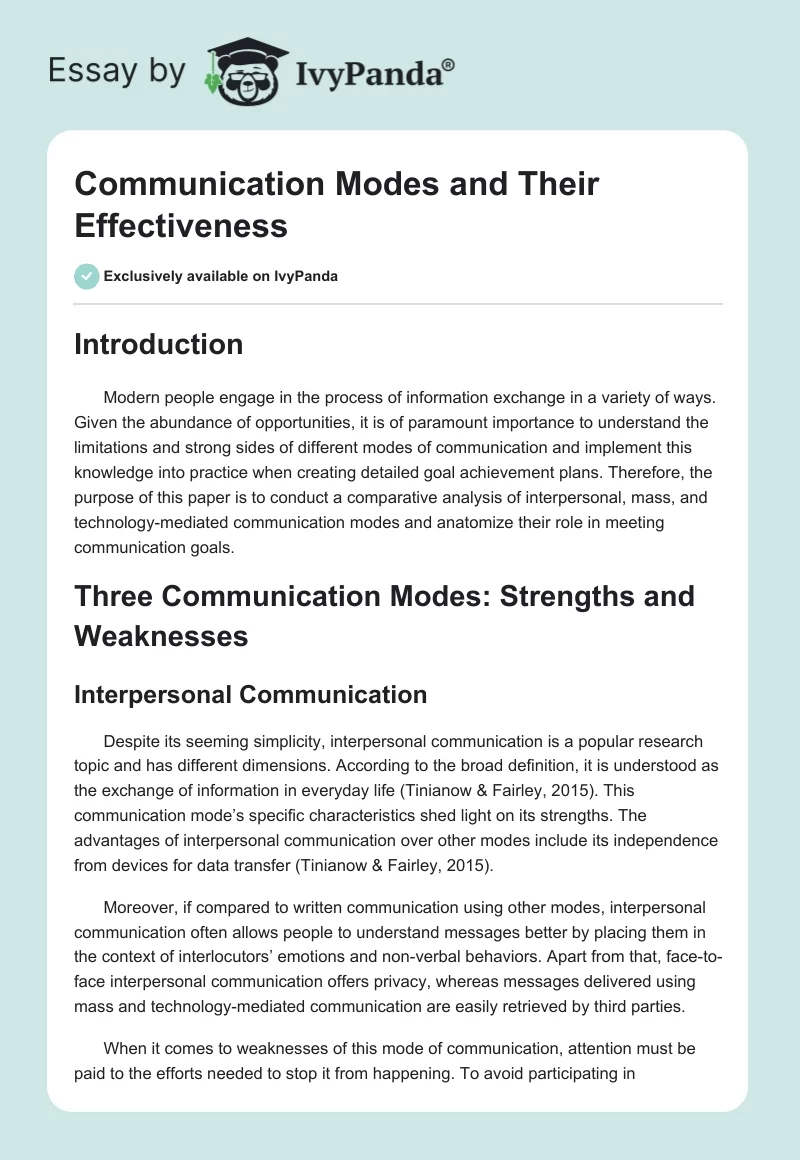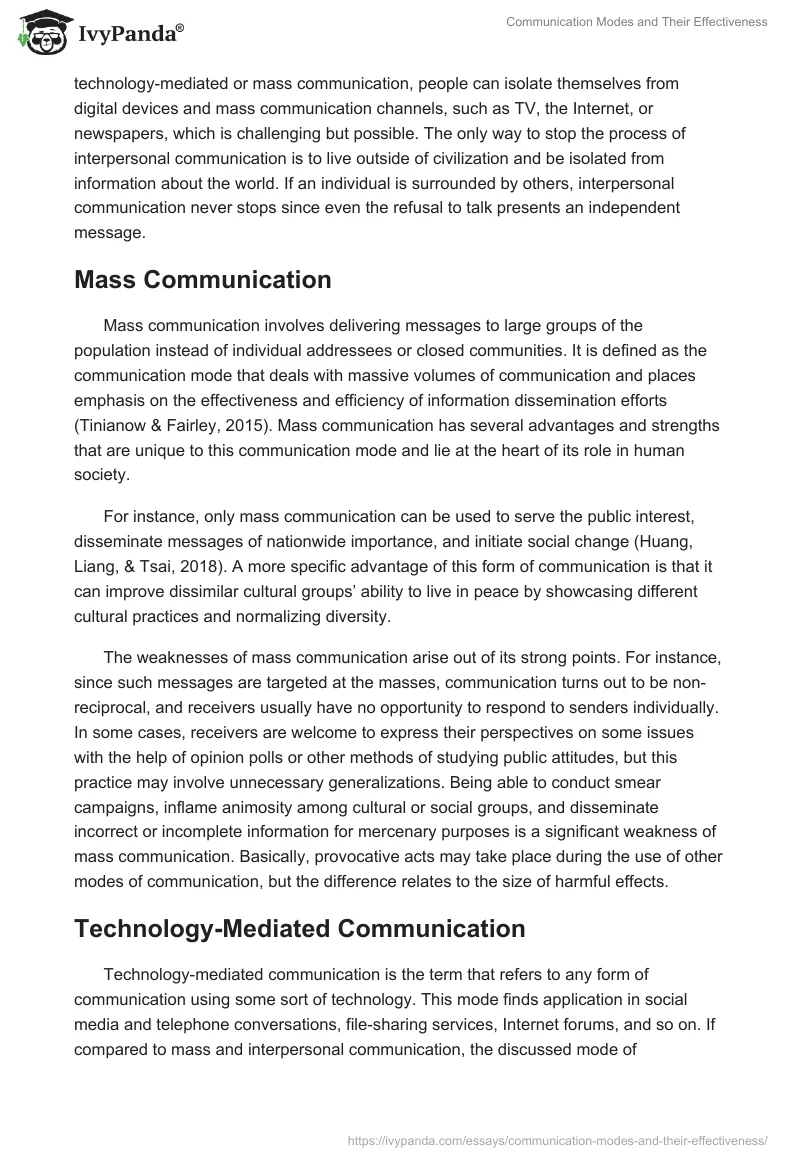Introduction
Modern people engage in the process of information exchange in a variety of ways. Given the abundance of opportunities, it is of paramount importance to understand the limitations and strong sides of different modes of communication and implement this knowledge into practice when creating detailed goal achievement plans. Therefore, the purpose of this paper is to conduct a comparative analysis of interpersonal, mass, and technology-mediated communication modes and anatomize their role in meeting communication goals.
Three Communication Modes: Strengths and Weaknesses
Interpersonal Communication
Despite its seeming simplicity, interpersonal communication is a popular research topic and has different dimensions. According to the broad definition, it is understood as the exchange of information in everyday life (Tinianow & Fairley, 2015). This communication mode’s specific characteristics shed light on its strengths. The advantages of interpersonal communication over other modes include its independence from devices for data transfer (Tinianow & Fairley, 2015).
Moreover, if compared to written communication using other modes, interpersonal communication often allows people to understand messages better by placing them in the context of interlocutors’ emotions and non-verbal behaviors. Apart from that, face-to-face interpersonal communication offers privacy, whereas messages delivered using mass and technology-mediated communication are easily retrieved by third parties.
When it comes to weaknesses of this mode of communication, attention must be paid to the efforts needed to stop it from happening. To avoid participating in technology-mediated or mass communication, people can isolate themselves from digital devices and mass communication channels, such as TV, the Internet, or newspapers, which is challenging but possible. The only way to stop the process of interpersonal communication is to live outside of civilization and be isolated from information about the world. If an individual is surrounded by others, interpersonal communication never stops since even the refusal to talk presents an independent message.
Mass Communication
Mass communication involves delivering messages to large groups of the population instead of individual addressees or closed communities. It is defined as the communication mode that deals with massive volumes of communication and places emphasis on the effectiveness and efficiency of information dissemination efforts (Tinianow & Fairley, 2015). Mass communication has several advantages and strengths that are unique to this communication mode and lie at the heart of its role in human society.
For instance, only mass communication can be used to serve the public interest, disseminate messages of nationwide importance, and initiate social change (Huang, Liang, & Tsai, 2018). A more specific advantage of this form of communication is that it can improve dissimilar cultural groups’ ability to live in peace by showcasing different cultural practices and normalizing diversity.
The weaknesses of mass communication arise out of its strong points. For instance, since such messages are targeted at the masses, communication turns out to be non-reciprocal, and receivers usually have no opportunity to respond to senders individually. In some cases, receivers are welcome to express their perspectives on some issues with the help of opinion polls or other methods of studying public attitudes, but this practice may involve unnecessary generalizations. Being able to conduct smear campaigns, inflame animosity among cultural or social groups, and disseminate incorrect or incomplete information for mercenary purposes is a significant weakness of mass communication. Basically, provocative acts may take place during the use of other modes of communication, but the difference relates to the size of harmful effects.
Technology-Mediated Communication
Technology-mediated communication is the term that refers to any form of communication using some sort of technology. This mode finds application in social media and telephone conversations, file-sharing services, Internet forums, and so on. If compared to mass and interpersonal communication, the discussed mode of communication allows building and maintaining long-distance relationships between friends or romantic partners (Chien & Hassenzahl, 2017).
Another strength that is unique to technology-mediated communication is that it helps to overcome distance barriers and use an affordable and accessible way to engage in real-time information exchange. For instance, meeting in person to clarify any new details of collaboration is an economically unviable option for business partners from different cities, whereas technology-mediated communication offers productivity without unnecessary travel expenses.
The mode of communication being discussed has two important weaknesses since not all of its forms involve receiving instant feedback, and technology-mediated messages can get into the hands of the wrong people. Some ways to use technology-mediated communication, for instance, video conferencing software, online chats, and telephones, enable communicators to receive instant responses to their messages, whereas interpersonal communication offers this opportunity every single time. Also, due to evolving hacking techniques, it is much easier to keep something a secret by discussing it face-to-face.
Communication Goals and the Modes of Communication
Goal One
The first communication goal that I may want to pursue is to learn how to recognize talents in my children as soon as possible. Basically, to accomplish it, I would have to receive substantial responses from people that have corresponding experience and be able to analyze them. To achieve the goal with the help of interpersonal communication, I would engage in face-to-face conversations with the parents of talented and successful children and encourage them to share their experiences and stories with me. Talking to only one person would not be enough to get meaningful responses and then use my generalization skills to identify the key talent recognition practices. To reach maximum effectiveness, I would initiate both one-on-one and group conversations.
Apart from that, mass communication could also be used to attain the selected goal. For instance, I would be able to get the required knowledge by engaging in mass communication as an information receiver and searching for mass media products covering the issue. Using the Internet, I would find articles written by specialists in child psychology and TV programs or blog posts devoted to talent identification.
Finally, it would be possible to compass the communicative goal with the help of technology-mediated communication. For instance, using the Internet, I would find a qualified specialist in childhood development and ask this professional for advice via a personal e-mail along with presenting the details of my case. Another way to make use of technology-mediated communication would be to start personal social media conversations to interview a few people and make conclusions.
Goal Two
The second communication goal involves making my upcoming poetry book popular and encouraging people to read it. To reach this objective, I would be able to engage in interpersonal communication with my relatives, friends, and acquaintances. All these people would be verbally informed about the book and the key themes in my poems and then be encouraged to pass this information on. In all fairness, informing multiple people about my project would require a lot of time.
To continue, mass communication strategies to popularize the book would include creating and disseminating information materials about it, my experiences as an author, and the reasons to get acquainted with my works. In particular, I would be able to raise people’s awareness of the book by creating blog posts devoted to the new book or asking my friends to repost my social media entries about the project. It could also be helpful to establish business relationships with popular bloggers or submit my works to well-known poetry magazines.
In the end, to achieve the goal with the help of technology-mediated communication, I would be able to phone up my friends, relatives, and acquaintances and contact them via e-mail and social media. Therefore, I would manage to keep them updated on the status and purposes of my project. Many of my social media friends also have a lot of subscribers, so this strategy would probably produce significant effects.
The Most Effective Means to Reach the Goals
As for the first goal, technology-mediated communication is expected to produce the best results since it removes constraints linked to physical distance and offers limitless opportunities for the interlocutor to choose. Interpersonal communication would help me to get unprofessional advice from people who know my situation, whereas mass media sources would provide more professional but less specific recommendations. Technology-mediated communication would help to strike the right balance between the two cases. Regarding the second goal, mass media communication presents the best way to promote the book because it allows reaching more people compared to other options. Thus, it increases the chances to attract the attention of users who love poetry.
Conclusion
To sum it up, interpersonal communication is not the only mode of communication available today since individuals are welcome to use the fruits of technological progress. Additionally, modern people have an opportunity to fulfill their goals with the help of mass communication by broadcasting their messages to the world. All three communication modes can be used to reach communicative goals, such as getting new knowledge or informing people about something, but their effectiveness varies depending on the type of goals.
References
Chien, W. C., & Hassenzahl, M. (2017). Technology-mediated relationship maintenance in romantic long-distance relationships: An autoethnographical research through design. Human-Computer Interaction, 1-48.
Huang, W. L., Liang, J. C., & Tsai, C. C. (2018). Exploring the relationship between university students’ conceptions of and approaches to learning mass communication in Taiwan. The Asia-Pacific Education Researcher, 27(1), 43-54.
Tinianow, D. E., & Fairley, M. S. (2015). Messages in context: An introduction to human communication. San Diego, CA: Bridgeport Education, Inc.


